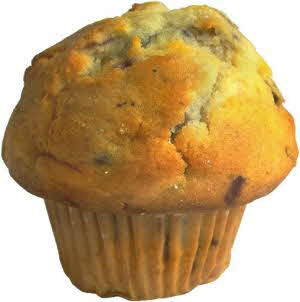THE MUFFIN MANFood for Thought - Feb 17, 2010 - Mark R. Vogel - Epicure1@optonline.net - Mark’s Article Archive Recipe below
Back in merry ole England in the 19th century there existed a street peddler known as the Muffin Man. Forever immortalized in the nursery rhyme of the same name, the Muffin Men plodded the streets of London with a tray of muffins, often carried on their heads. To alert the public to their presence they rang a bell, much like the neighborhood ice cream trucks of the modern day. It is estimated that there were as many as 3,000 muffin men clanging their way through the English capitol. Apparently this caused quite a raucous as the public complained, spurring a Parliamentary interdiction in 1840 limiting the use of the bell. Supposedly this had little effect and the peal of the undaunted muffin men continued to reverberate through the city.

Seinfeld Muffin Tops When I think of muffins I can’t help but recall the episode of Seinfeld entitled “The Muffin Tops.” Elaine, who only relishes the muffin tops, suggests a harebrained scheme to open a muffin shop that only sells the tops. Her ex-boss Mr. Lippman decides to run with it and does just that. However, something goes wrong as the muffin tops are insipid. He consults Elaine who discovers that he is only baking the tops. The “secret” to the top’s flavor is baking the entire muffin and then breaking off the stumps. This succeeds but now Lippman is left with hoards of muffin stumps. They try to donate them to the homeless but they rebuff their measly leftovers. With no other options they turn to the gluttonous and conniving Newman. In a spoof of Harvey Keitel’s character in the movie “Pulp Fiction,” (Keitel played a “cleaner,” an underworld figure who repairs botched situations), Newman arrives with a large cache of milk and proceeds to consume the staggering stockpile of muffin stumps. A muffin is a type of quick bread, i.e., a bread which receives its leavening from a chemical, usually baking powder and/or soda, as opposed to yeast. Yeast breads must also be kneaded and rested; steps unnecessary with quick breads. Other classical quick breads include pancakes, cornbread, and biscuits. The word muffin derives from one or two possible sources: the French word “moufflet,” which refers to soft bread and the German word “muffe,” meaning cake.
Interestingly, what the Seinfeld clan and most people in the US refer to as a muffin is an American transformation. The original muffins of England were a yeast-based bread, more analogous to a traditional bread than a cake. The popular brand Thomas’ English Muffins® are truer to their seminal namesake than what Newman gorged himself on.
American muffins, as stated, are more cake-like. But unlike a finely textured, standard cake, muffins have a denser consistency. This results from hand stirring the ingredients as opposed to ardently whipping the butter, sugar, and remaining elements in an electric mixer. This latter, cake-making technique is known as the “creaming method.” Muffins also tend to be less sweet than a regular cake. A gazillion variations exist employing a myriad of flavoring agents such as fruits, nuts, grains, chocolate, and combinations thereof. Homemade muffins, devoid of any chemical preservatives go stale rather quickly so eat’em up and/or give some to the neighbors.
RECIPE
BANANA MUFFINSFor the batter:
~ 1 ¾ cups all purpose flour
~ 2 ½ teaspoons baking powder
~ ¾ teaspoon salt
~ 1 egg
~ 1 cup sugar
~ 2 large or 3 medium very ripe bananas, mashed
~ ¼ cup buttermilk
~ 4 tablespoons butter, melted
~ 4 tablespoons vegetable oil
~ 1 ¼ teaspoons banana extract
~ Vegetable spray, as needed
For the topping:
~ 1/3 cup light brown sugar
~ 5-6 tablespoons flour
~ 1/8 teaspoon cinnamon
~ 3 tablespoons cold butter, cubed
Directions Preheat oven to 425.
Whisk the flour, baking powder and salt in a bowl.
In a separate bowl whisk the egg and sugar until it lightens and becomes a little fluffy.
Stir in the mashed bananas, buttermilk, butter, vegetable oil and banana extract.
Add the wet ingredients to the dry and stir. They do not need to be thoroughly combined; some lumpiness is desirable.
Spray a standard 12-muffin pan with vegetable spray. Fill the muffin pan with the batter. Do not fill to the brim.
Mix the ingredients for the topping together with a fork until a crumbly texture is achieved. A little extra flour may be needed. Sprinkle one heaping tablespoon of the topping over the top of each muffin.
Bake for 18 minutes, or until the muffins are done, rotating the pan once. They should be springy to the touch.
Also Visit Mark’s website: Food for Thought Online
| 